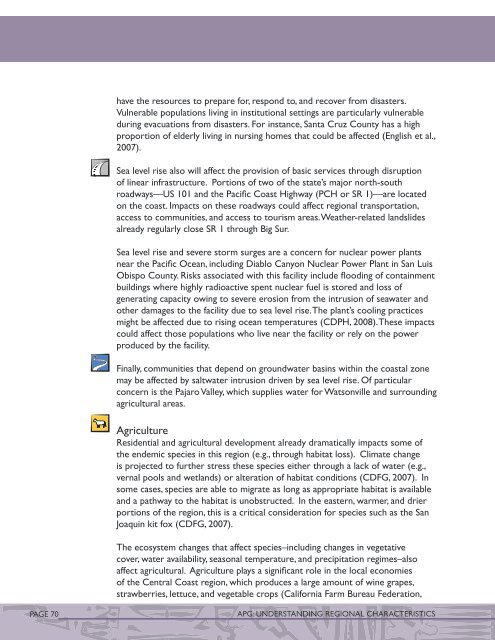addressing climate change adaptation in regional transportation plans
addressing climate change adaptation in regional transportation plans
addressing climate change adaptation in regional transportation plans
Create successful ePaper yourself
Turn your PDF publications into a flip-book with our unique Google optimized e-Paper software.
have the resources to prepare for, respond to, and recover from disasters.Vulnerable populations liv<strong>in</strong>g <strong>in</strong> <strong>in</strong>stitutional sett<strong>in</strong>gs are particularly vulnerabledur<strong>in</strong>g evacuations from disasters. For <strong>in</strong>stance, Santa Cruz County has a highproportion of elderly liv<strong>in</strong>g <strong>in</strong> nurs<strong>in</strong>g homes that could be affected (English et al.,2007).Sea level rise also will affect the provision of basic services through disruptionof l<strong>in</strong>ear <strong>in</strong>frastructure. Portions of two of the state’s major north-southroadways—US 101 and the Pacific Coast Highway (PCH or SR 1)—are locatedon the coast. Impacts on these roadways could affect <strong>regional</strong> <strong>transportation</strong>,access to communities, and access to tourism areas. Weather-related landslidesalready regularly close SR 1 through Big Sur.Sea level rise and severe storm surges are a concern for nuclear power plantsnear the Pacific Ocean, <strong>in</strong>clud<strong>in</strong>g Diablo Canyon Nuclear Power Plant <strong>in</strong> San LuisObispo County. Risks associated with this facility <strong>in</strong>clude flood<strong>in</strong>g of conta<strong>in</strong>mentbuild<strong>in</strong>gs where highly radioactive spent nuclear fuel is stored and loss ofgenerat<strong>in</strong>g capacity ow<strong>in</strong>g to severe erosion from the <strong>in</strong>trusion of seawater andother damages to the facility due to sea level rise. The plant’s cool<strong>in</strong>g practicesmight be affected due to ris<strong>in</strong>g ocean temperatures (CDPH, 2008). These impactscould affect those populations who live near the facility or rely on the powerproduced by the facility.F<strong>in</strong>ally, communities that depend on groundwater bas<strong>in</strong>s with<strong>in</strong> the coastal zonemay be affected by saltwater <strong>in</strong>trusion driven by sea level rise. Of particularconcern is the Pajaro Valley, which supplies water for Watsonville and surround<strong>in</strong>gagricultural areas.AgricultureResidential and agricultural development already dramatically impacts some ofthe endemic species <strong>in</strong> this region (e.g., through habitat loss). Climate <strong>change</strong>is projected to further stress these species either through a lack of water (e.g.,vernal pools and wetlands) or alteration of habitat conditions (CDFG, 2007). Insome cases, species are able to migrate as long as appropriate habitat is availableand a pathway to the habitat is unobstructed. In the eastern, warmer, and drierportions of the region, this is a critical consideration for species such as the SanJoaqu<strong>in</strong> kit fox (CDFG, 2007).The ecosystem <strong>change</strong>s that affect species–<strong>in</strong>clud<strong>in</strong>g <strong>change</strong>s <strong>in</strong> vegetativecover, water availability, seasonal temperature, and precipitation regimes–alsoaffect agricultural. Agriculture plays a significant role <strong>in</strong> the local economiesof the Central Coast region, which produces a large amount of w<strong>in</strong>e grapes,strawberries, lettuce, and vegetable crops (California Farm Bureau Federation,PAGE 70APG: UNDERSTANDING REGIONAL CHARACTERISTICS
















